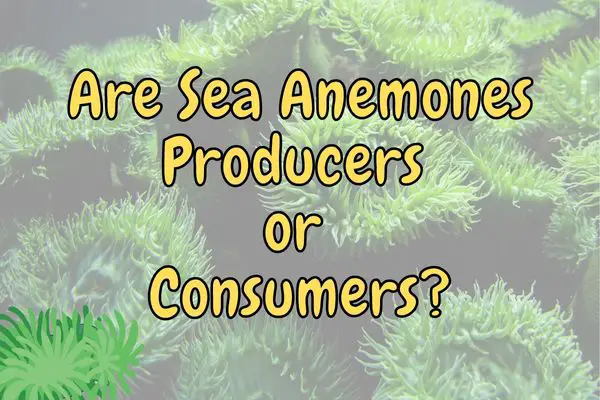Anemones are beautiful creatures that live in the ocean. They are related to corals and jellyfish and have a very interesting way of eating.
Although they might look like plants (producers), sea anemones are animals and secondary consumers (omnivores), which means that they eat both plants and other animals. They use their tentacles to capture small prey like fish, plankton, and mussels. They are heterotrophs and do not produce energy.
Since anemones are secondary consumers, this means that they eat other animals that have already eaten plants.
This is important because it helps transfer energy up the food chain from plants all the way to top-level predators.
Contents
Are sea anemones producers or consumers?
Sea anemones are classified as consumers rather than producers. They belong to the phylum Cnidaria and are considered predatory animals. They primarily obtain their energy by consuming other organisms, such as small fish and invertebrates.
Sea anemones are typically found in marine environments, ranging from shallow coastal areas to deeper oceanic regions.
While they do not require light for their own energy production, light can indirectly affect them through their symbiotic relationship with photosynthetic organisms.
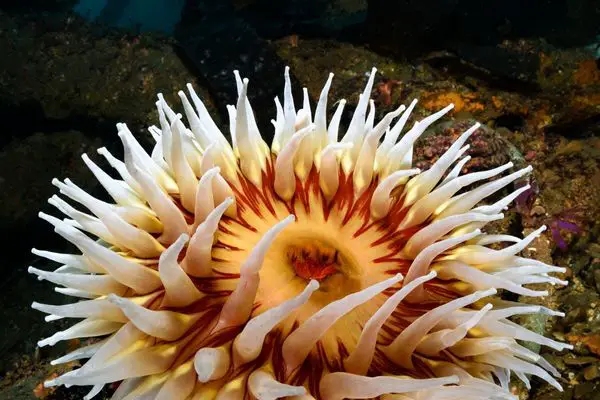
One well-known example of a symbiotic relationship involving sea anemones is the association with certain species of zooxanthellae, which are photosynthetic algae.
These algae live within the tissues of the sea anemone and benefit from the protection and nutrients provided by the anemone. In turn, the zooxanthellae perform photosynthesis, producing organic compounds that can be utilized by the sea anemone for additional energy.
The most famous species that exhibits this symbiotic relationship is the sea anemone known as the “anemonefish” or “clownfish” (Amphiprioninae). These small fish have a mutualistic partnership with certain sea anemone species, such as Heteractis magnifica or Entacmaea quadricolor.
The clownfish live within the anemone’s tentacles, gaining protection from predators, while they provide food scraps and help in oxygen circulation. The zooxanthellae in the anemone also benefit from the clownfish’s excretions, which provide them with additional nutrients.
While light is not essential for the survival of sea anemones, it indirectly plays a role in their symbiotic relationship with zooxanthellae. The presence of light is necessary for photosynthesis to occur in the algae, and this process is vital for the production of organic compounds that support the sea anemone’s energy needs.
It’s important to note that not all sea anemones have a symbiotic relationship with photosynthetic organisms, and some species are entirely independent consumers, relying solely on capturing and consuming prey for their nutrition. The classification of sea anemones as consumers is based on their primary mode of obtaining energy, which is through the consumption of other organisms rather than producing their own energy through photosynthesis.
Diet and Habitat of Anemones
Anemones are stony, marine colonial animals in the class Anthozoa, order Actiniaria. They are usually sessile (non-motile), which they use as a defense mechanism by hiding from predators among their tentacles.
Anemones can be found living close to many other organisms. They are mostly found dwelling in cool water under rocks or floating or drifting near the surface of the water. Anemones are located very near the bottom in the marine food web.
Anemones also inhabit the sediment where they can be found hiding, often attached to hard surfaces, between rocks, in cracks, or in crevices. Anemones can also live attached to another animal, usually a sea anemone host.
Anemones eat smaller organisms such as single-celled algae or small crustaceans but they can also eat larger animals like worms or mussels and even fish!
The mouth is near the center of their bell-shaped bodies with a ring of five to eight radial canals that allows water to circulate into it.
Digestive enzymes extract nutrients from food particles trapped inside these canals before being passed into a central gastrovascular cavity where bacteria further digest them before they exit through another ring of pores in the anemone’s body wall called papillae on its tentacles.
The waste is then expelled via either exhalent (excretory) pore(s) at one end of each arm or excretory duct(s) leading to one opening at the opposite end/free edge where it is eventually discharged into seawater surrounding the main body mass (this excretion process occurs over several days).
Some species have specialized tissues called nematocysts which store toxins that can be used against predators either when directly injected into the target tissue or if ingested after being broken off during the eating process.
These toxins also help fend off potential predators and competitors since many species compete with each other for space on hard surfaces like rock ledges and reefs.
However, some species are more aggressive than others and some invasive species such as Actinia equina may spread quickly to outcompete other species.
Why are Sea Anemones Important for the Ecosystem?
Anemones play an important role in the ecosystem by providing a home for other animals, recycling nutrients, and helping to control the population of other animals.
Anemones help to recycle nutrients in the ecosystem. They eat small pieces of dead plants and animals which help to keep these materials from polluting the water. They also excrete waste that is rich in nitrogen which can be used by other organisms as a fertilizer.
Anemones help to control populations of other animals by eating them or competing with them for food.
By eating zooplankton, fish larvae, and small invertebrates, they help keep these populations under control. By competing with algae for space they help to prevent the overgrowth of these plants.
Anemones provide a home for many different animals including clownfish, crabs, shrimp, and others.
These animals live in a symbiotic relationship with the anemone where they receive protection from predators and parasites and the anemone receives food from them.
The most notable of these relationships is the one with the clownfish (Nemo!).
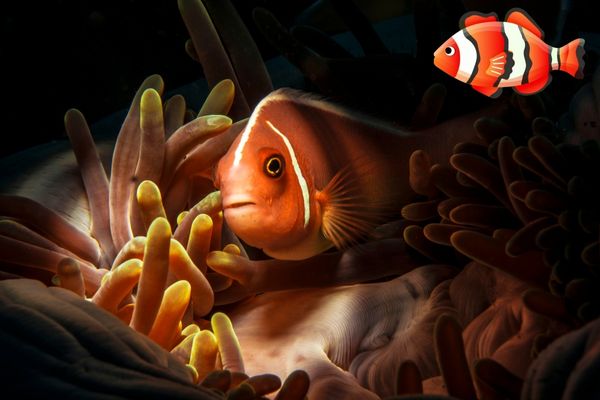
The clownfish and the sea anemone have an almost symbiotic relationship. The clownfish lives among the tentacles of the anemone and is protected from predators. In return, the clownfish brings food to the anemone and cleans it of debris.
Are Anemones Carnivores, Herbivores or Omnivores?
Anemones are omnivores because they eat both plants and animals. Anemones usually prefer to eat animals, but they also eat microscopic animals. They are more carnivores than herbivores as they cannot live from plant material alone.
They simply cannot catch enough algae due to their stationary lifestyle. They need animals to come to them to feed on them.
This is in contrast to other stationary sea animals like sea squirts or sponges that feed mainly by filter-feeding of microscopic planktons.
Are Anemones Producers, Consumers, or Decomposers?
Anemones are consumers because they eat other living things. Anemones are omnivores, which means that they eat both plants and animals.
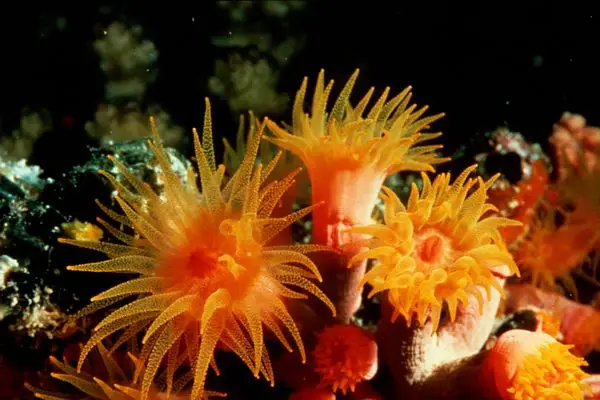
In general, plants are producers and animals are consumers. Bacteria and fungi act as decomposers but not anemones.
What Type of Consumer is a sea Anemone?
Sea anemones are classified as secondary consumers. As predatory animals, they occupy a position in the food chain where they feed on primary consumers, which are herbivores or other animals that directly consume plants or algae. Sea anemones typically capture and consume small fish, crustaceans, and other invertebrates.
In marine ecosystems, the food chain often starts with primary producers, such as algae and phytoplankton, which convert energy from sunlight into organic matter through photosynthesis. Herbivores, or primary consumers, then feed on these producers. Sea anemones, as secondary consumers, prey upon these primary consumers.
It’s worth noting that some sea anemones engage in symbiotic relationships, such as the mutualistic association with clownfish, where the anemone benefits from the fish’s presence while the fish receives protection. In these cases, the sea anemone’s diet may include scraps or leftovers from the clownfish’s meals, but they still primarily rely on consuming other animals in their environment to meet their energy requirements.
So, sea anemones are secondary consumers as they feed on primary consumers in the marine food chain.
Can Anemones be Considered Decomposers?
No, sea anemones are not considered decomposers. Decomposers are organisms that break down dead organic matter and waste materials, returning nutrients to the ecosystem. They play a crucial role in the recycling of nutrients and the decomposition process.
Sea anemones, on the other hand, are predatory animals that primarily feed on live prey. They capture and consume small fish, invertebrates, and sometimes even larger organisms. Sea anemones are not equipped with the necessary adaptations or digestive systems to efficiently break down dead organic matter. Their diet consists mainly of living organisms rather than decaying material.
While sea anemones may indirectly contribute to nutrient recycling through their waste products, they are not considered decomposers in the true sense of the term. Their role in marine ecosystems is primarily as consumers within the food chain, rather than as decomposers that break down dead organic material.
Where are Anemones in the Food Chain?
Because sea anemones feed on small aquatic animals like crustaceans, krill and small fish. Anemones are secondary consumers because they eat animals that in turn, eat plants.
Sea anemones are typically found in various positions within the food chain of marine ecosystems, depending on their size, species, and habitat. They can occupy different trophic levels, acting as both primary and secondary consumers.
As primary consumers: Some sea anemones feed on the primary producers of the marine ecosystem, such as phytoplankton and algae.
They consume microscopic organisms and detritus present in the water column or within the sediments. These anemones are considered primary consumers, as they directly obtain their energy by consuming plant-like organisms or organic matter derived from them.
As secondary consumers: The majority of sea anemones are secondary consumers. They occupy a higher position in the food chain and feed on primary consumers, such as small fish, crustaceans, and other invertebrates.

Sea anemones use their venomous tentacles to capture and immobilize their prey, then ingest and digest them for sustenance. This feeding strategy places them as secondary consumers, obtaining energy from the animals lower in the food chain.
It’s important to note that the specific role of sea anemones in the food chain can vary depending on their habitat and ecological interactions.
For example, some sea anemones have mutualistic relationships with other organisms, such as clownfish, where both species benefit. In such cases, the anemone’s diet may also include leftover food or scraps from the associated organism, expanding their ecological niche.
Overall, sea anemones can occupy different positions in the marine food chain, functioning as primary consumers when feeding on plant-like organisms and detritus or as secondary consumers when preying on smaller animals.
Are Anemones Autotrophs or Heterotrophs?
Sea anemones are heterotrophs because they are animals. Anemones eat other things, and they cannot make their own food through photosynthesis as plants can. Only plants and some bacteria and archaea make their own food through photosynthesis or inorganic chemicals.
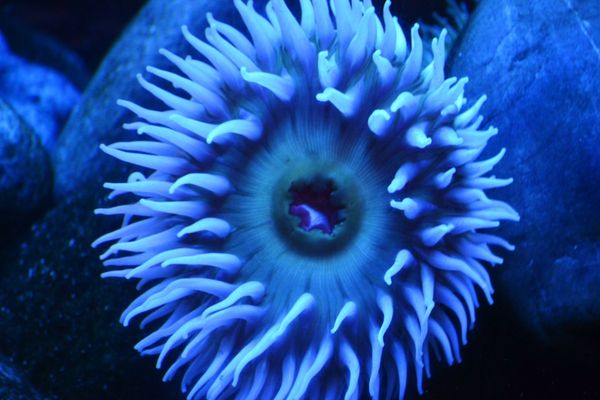
But all animals get their energy through eating other animals.
What Animals Prey on Anemones?
Anemones have very few predators because they sting and are toxic, but may sometimes be eaten by fish like flounders, eels and cod but also starfish and snails will eat sea anemones.
Anemones are marine animals that belong to the phylum Cnidaria. They have a soft body with tentacles that can sting and capture prey.
Anemones are usually attached to rocks or other substrates, but some can move around by gliding on their base. Anemones have a symbiotic relationship with some fish, such as clownfish, that live among their tentacles and protect them from predators.
However, anemones are not immune to predation. Some animals that prey on anemones are sea stars, nudibranchs, crabs, snails, and fish. Sea stars can use their tube feet to pull apart the anemone’s base and eat its soft tissues.
Nudibranchs are colorful sea slugs that can feed on anemones by avoiding their stings or by incorporating their nematocysts (stinging cells) into their own bodies. Crabs and snails can use their claws or shells to break off pieces of the anemone and consume them.
Fish, such as butterflyfish and angelfish, can nibble on the anemone’s tentacles or bite off its mouth.
Conclusion
In this blog post I have looked into the diet of the sea anemone as a fascinating animal that has a very interesting relationship with its environment.
The sea anemone is a carnivorous animal that feeds on the small invertebrates that live in the water.
The sea anemone is a very interesting animal because it is a carnivore and a herbivore, which makes it an omnivore and a secondary consumer.
This means that it feeds on the dead bodies of other animals that have died in the water.
The anemone is a very important part of the food chain in many aquatic habitats.
In this blog post I have looked into the diet of the anemone and how it has adapted to its environment and the different food sources available to it.
Anemones are very popular in aquariums and many people enjoy keeping them in their gardens.
I hope you enjoyed reading this blog post, and I do encourage you to look into my other articles on this blog for more exciting facts about wildlife and animal diets!

